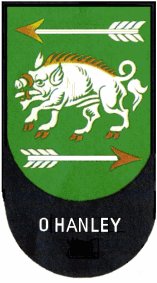![]()

![]()


|
|
|
|
|
|
|
Motto: VI ET Animo (By Strength and Courage)
"The Gallant Archer Forever."
![]()
The History of the Family name of:
"O'Hanley"
Welcome to the Irish family site.
Line of Descent:
|
Eochaidh XII, |
King of Ireland |
A.D. 357-365. |
|
Brian, |
King of Connacht |
A.D. 366-388 |
|
Erc the Red, |
(Earc Dearg) |
(See Below) |
|
Aengus, |
(See Below) |
(See Below) |
|
Dubhthach, |
(Dubtac Duffa) |
(See Below) |
|
Aengus, |
(See Below) |
(See Below) |
|
Dubhthach, |
(See Below) |
(See Below) |
|
Uan, |
(See Below) |
(See Below) |
|
Chitecar, |
(See Below) |
(See Below) |
|
Maolduin, |
(See Below) |
(See Below) |
|
Murtuile, |
(See Below) |
(See Below) |
|
Ainle, |
(See Below) |
(See Below) |
|
Muirceartac, |
(See Below) |
(See Below) |
|
Teige, |
(See Below) |
(See Below) |
|
Donal, |
(See Below) |
(See Below) |
|
Teige, |
(See Below) |
(See Below) |
|
Murrough, |
(See Below) |
(See Below) |
|
Raghnall, |
Chief of the Sept. |
Slain at Clontarf 1014. |
|
Murtagh, |
(See Below) |
1030 |
|
Iomhar Mor, |
(See Below) |
(See Below) |
|
Ainle, |
(See Below) |
(See Below) |
|
Donal, |
(See Below) |
(See Below) |
|
Iomhar, |
(See Below) |
(See Below) |
|
Donal, |
O'Hainlige |
(or O'Hanley) |
Chief of "Cinel Dubhthach," (King Duffa) or Doohy Hanley. Meaning of name Descendents of Ainle, the comely or good-looking man.
![]()
Eochaide XII Ard Right of Ireland or High King of Ireland, of the line Heremon, son of Milesius of Spain, was ancestor of most of the Gaelic families in Meath, Ulster, and Connacht. Brian, King of Connacht, AD 366-388. The eldest son of Eochaide, was the father of Erc the Red. From whose brother Duach Galach (the Valiant) sprung O'Conner, O'Rourke, O'Reilly, etc., and from who's brother Conall O'Malley Erc the Red was father of Angus, who had two sons, namely; Onach, the druid ancestor of Max Branan and Dubhthac (the dark haired) ancestor of Hanley. Their territories lay along the river Shannon, in the Present County of Roscommon, separated by a row of pillar stones and crosses on the Crest of Slieve Bawn.
![]()
The Posterity of Dubhthach (pronounced Duffa) possessed and gave name to Kinel Duffa (cenel dubeaic race of Dubhthach), later called Doohy-Hanley, lying mainly between Slieve Bawn and the Shannon comprising the present parishes of Kilglass Cloontuskert, Termonbarry, and half of Lissonuffy, about 22,000 acres, protected by mountain, wood and water. Raghnall, Chief of the Sept. fell, leading his battalion at the great victory of Clontarf over the Danes in 1014; sixth in descent from him was Donal O'Hainleaig or O'Hanley, first of the surname, who adapted it from his ancestor Ainle (a name meaning well featured or good-looking).
![]()
The chief O'Hanley tigearna or Lord of Kinel Duffa, was one of the twelve principle officials of Connacht, with charge of the Shannon fleet. The succession of chiefs, with their various exploits, is recorded in over forty notices in the Four Masters. In 1151 they built the great stone church of Kilbarry, named in honor of their kinsmen and patron, St. Barry (Festival, Feb. 15). This and the chancel of Cloontuskert Abbey were their place of internment. As armorial bearings (recorded in the Irish Heraldry Office) they took the wild Boar of their native forests, emblem of rugged strength and courage, on a field of green amid arrows, with the motto (translated): "The Gallant Archer Forever."
![]()
Bishop Donat O'Hanley ruled the diocese of Dublin, 1085-1095. He was succeeded by his nephew, Bishop Samuel O'Hanley, 1095-1121. Foreign aggression occurred in 1311, when Tiege O'Hanley was slain by Jordan D'Exeter, Sheriff of the English colony; but the attempt at subduing the Sept. failed and they maintained their independence for centuries under their own chiefs, including Donal O'Hanley, who died in 1358. "After gaining victory over the world and the devil." In 1595-1600 under Fergananim O'Hanley, they aided Red Hugh and O'Conor Don in the war for Irish liberty. The Rev. John O'Hanley, Franciscan, suffered martyrdom for his faith, August 10, 1580.
![]()
In the 16th century James O'Hanley, son of the chief, moved, in consequence of a duel to Limerick, where his descendants acquired Toreen and other large estates and built Meadstone Castle in Dromin Parish, two miles south of Bruff. Some of this branch altered the name including, Nicholas and John Haly, of the Catholic Confederation, 1646: Sir John Haly, M.D., of Cork (D. 1798) and Chevalier Richard O'Haly, of the Irish Brigade of France. (D. 1816) But, Captain Robert Hanley, who fought in the campaigns of Fredrick the Great, resumed the old name and died aged ninety in France in 1821, leaving issue.
The Cromwellians dispossessed the O'Hanley's of both Roscommon and Limerick and dismantled Meadstone Castle. In 1661 Farriah O'Hanley of Slieve Bawn got back his lands. A recent census showed about 5,000 of the name Hanley in Ireland.
The Sept of O'Hanley:
"Dutaid don feadan arpungeip, Cenel dubta ndlutaimpeidh I'm cpide ar oireacht O' hainlige."
"Heritage of the sharp weaponed Kinel Dufa, strong and rugged! There is affection in my heart for the stock of the O'Hanley's."
John Duggan.
14th Century.
![]()
Author: Nollaig O'Hainle
(Chris Hanley) Oceanside, CA 92054 ©1999Formally, from Limerick City Ireland.
Should the music stop! Hit the page "Refresh"
Music: "James Last & Orchestra - Ireland - "Only Our Rivers Run Free"
Best viewed with Internet Explorer 4.0 or above and Windows Media Player7
To continue to view other poems, select from the links below.
Last time reviewed 08/31/2002
To view additional Irish content follow the links below:
"Limerick City, Home of Angela's Ashes"
Limerick Leader Online:
Limerick Post Online:
A New Limerick Site: